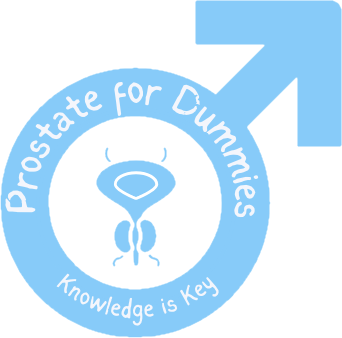Understanding the Prostate Gland A Guide for Beginners will give you a basic understanding of one of the lesser-discussed parts of male anatomy: the prostate gland. Despite its humble size, this small, walnut-sized gland plays a pivotal role in the male reproductive system. Now, what is the prostate, exactly? It’s a gland that sits just below the bladder, it surrounds the urethra (tube) that urine and semen pass through.
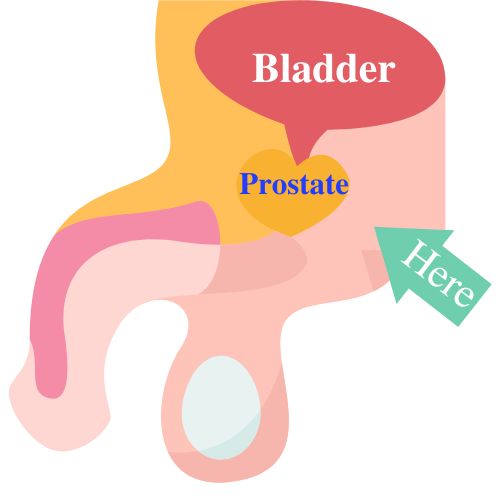
Every man has a prostate.
It starts off small (walnut-sized) and may become larger after 40 years of age.
If it does become larger it is not unusual. The statistics do not lie
- By age, 50 – 50% of men have an enlarged prostate.
- By age, 60 – 60% of men have an enlarged prostate.
- By age, 70 – 70% of men have an enlarged prostate.
- By age, 80 – 80% of men have an enlarged prostate.
- By age, 90 – 90% of men have an enlarged prostate.
Signs that you may have an enlarged prostate.
An enlarged prostate is known as Benign Prostatic Hyperplasia. Benign – meaning it is not dangerous.
Note: it might not be dangerous, but it is a problem.
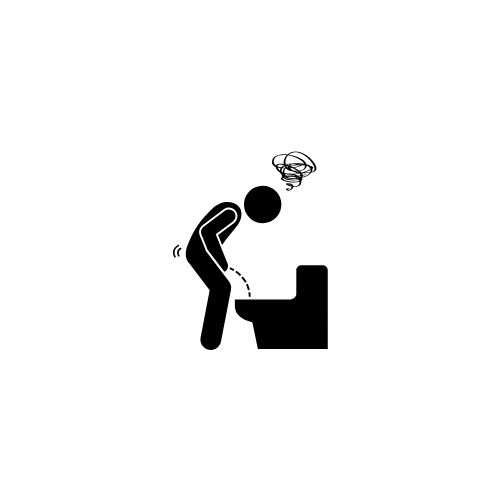
- You have a weaker urine stream than you had when you were younger.
- You find that you need to urinate more frequently.
- You find it difficult to get the last few drops of urine to come out and may end up in your underwear.
- You get up frequently at night to urinate and then do not produce much urine.
- It is just easier to sit down to urinate. Helps to drain the bladder.
From the statistics, an enlarged prostate is not unusual, chances are that someone you know is dealing with this. But chances are also high that they will not talk about it. Men do not discuss urinary functions. Back when you were younger you may have had a pissing contest with your friends, but as we get older, we no longer discuss these things.
First things – if you have any of the symptoms above, talk to your doctor. Every man has a prostate, and your doctor can help you discover if you have BPH or if there is a more serious issue. An enlarged prostate is most likely benign, but you may have cancer and a simple PSA (blood) test can help to determine if you need further testing or not.
PSA test – Prostatic Specific Antigen – a simple blood test that will help your doctor to determine if you are at risk of having prostate cancer.
Why do I care about my prostate?
You might be curious about why the prostate is significant. Well, it’s responsible for secreting prostate fluid, one of the components of semen. The muscles of the prostate gland also help propel this fluid into the urethra during ejaculation, which gives it a crucial role in male fertility.
But this isn’t just about reproduction; the health of the prostate affects overall well-being. Problems with the prostate can lead to uncomfortable symptoms, impacting not just the reproductive system but also the urinary tract. That’s why understanding the prostate is key to maintaining health and quality of life.
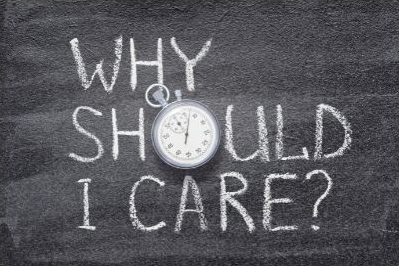
Most men do not know what the prostate is, nor what its function is in their lives. unfortunately, it is something that we are not concerned about until we have to be.
Prostate problems are slow to develop, you do not even know you have a problem until the symptoms are impossible to ignore.
As long as 10 years ago I noticed that often once finished urinating I would have one or two drops of urine that seemed to want to hang around until I had tucked myself back into my pants. After which they would inevitably make their way out and dampen my shorts. Sometimes even leaks outside my pants.
I remember a time in the old Don Muang Airport lounge waiting for a flight when I ran into a directional driller. He commented that I had a small trail of urine on the front of my pants. He was very nonchalant about it, simply saying “It happens to all of us.”
At the time I had no idea the cause behind this strange phenomenon. It just was. I have since learned the cause and it is my prostate. So you see, I had one of the signs of a prostate problem as long as 10 years ago. I was 53.
To ensure a comprehensive grasp of the topic, this guide will seamlessly transition into a visual exploration of the prostate. You’re going to find out about its exact location and learn how it operates within the male body. Just remember, keeping an eye on prostate health is as important as any other aspect of wellness.
Perhaps, because prostate problems are not discussed, and they manifest so slowly it is one of the most important aspects of male health.
Visualizing the Prostate: Understanding Its Placement and Function
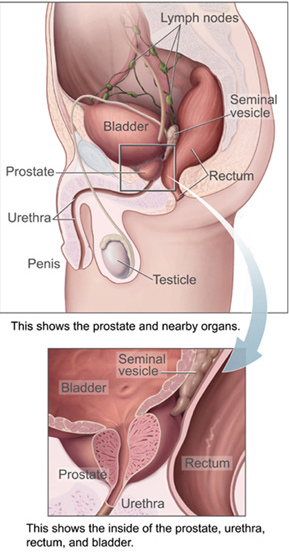
If you’re curious about the prostate gland, it is a small but vital organ tucked away deep in the pelvis. Understanding the prostate involves more than just knowing its job, it’s also about visualizing where it sits and why that’s important.
Imagine a walnut-sized gland snuggled just below the bladder, wrapping around a part of the urethra (the tube that your piss uses from your bladder to your penis) like a snug ring. This proximity to the bladder and urethra is why prostate health is so crucial. It is at the crossroads of urinary and reproductive paths. The prostate can affect both your ability to drain your bladder and your abilities in the sack. This effect on your ability to piss is why problems are noticed quickly.
To make this visualization complete, imagine a picture showing the prostate’s location: a diagram could show it nestling right between the base of the penis and the rectum, providing a clear view of its central position. It’s an organ you might not think much about, but like the keystone in an arch, its role in maintaining the flow and health of your body is undeniable.
The prostate’s primary function is to produce a fluid that protects and enriches sperm, playing a pivotal role in fertility. While that’s its headline act, it’s also part of a complex system of glands and channels that work tirelessly without any conscious thought from you, it’s all part of the body’s impressive autonomy.
Jumping ahead to the next section, which is ‘Demystifying Benign Prostatic Hyperplasia (BPH)’, it’s important to remember that while the prostate is relatively modest in size, it can cause significant issues as you age. Just like any vital part of the machinery that is your body, it requires maintenance and attention, and sometimes things can go awry, leading to conditions like BPH.
Demystifying Benign Prostatic Hyperplasia (BPH)
You’re going to find out about something called Benign Prostatic Hyperplasia, or BPH for short. It sounds complex, but it’s actually a common condition that many men encounter as they age. Essentially, BPH is an enlargement of the prostate gland that isn’t associated with cancer.

I’m here to help you understand just how widespread BPH is. Statistically, over half of men in their sixties, and as many as 90% in their eighties and nineties, may have some symptoms of BPH.
In my opinion, it’s not only the numbers that matter but also mindful awareness. BPH doesn’t happen overnight; it develops gradually as prostate cells multiply and cause the gland to enlarge. This enlargement can put pressure on the urethra, which runs through the center of the prostate, leading to urinary issues.
Knowing what BPH is and its challenges will help you recognize symptoms early on. Early detection can mean more treatment options and potentially a better outcome.
Read on to understand the progression of BPH and how it could affect your body. It’s important to visualize not just the concept of an enlarged prostate but also the real consequences it can have. Moving into the next section, we compare a healthy prostate to a prostate with BPH.
Prostate Analysis: A Side-by-Side Look at Health vs. BPH
You’re about to get a clearer picture — literally. Understanding the differences between a healthy prostate and one affected by Benign Prostatic Hyperplasia (BPH) is crucial. A healthy prostate is about the size of a walnut, smooth and symmetrical. In contrast, a prostate with BPH is enlarged, and this can cause the gland to press against the urethra, affecting urine flow.
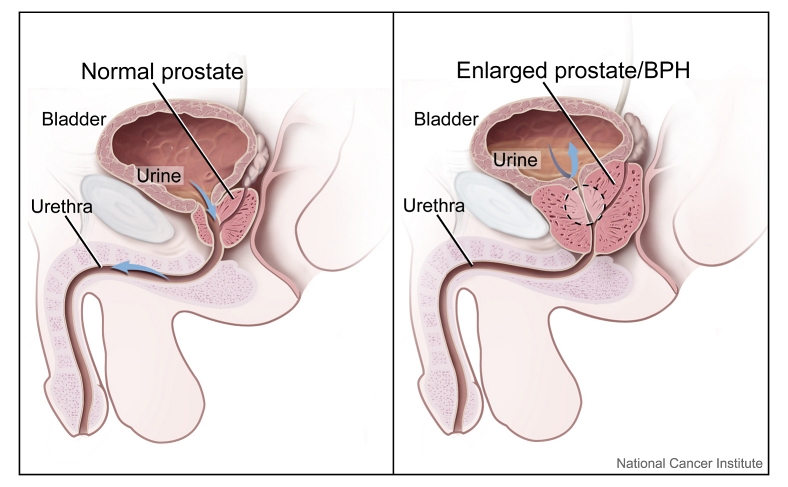

Note: Your prostate doubles in size during puberty to about the size of a walnut. Then, after ~25 years of age, it is continually growing.
To date, we are not sure why the prostate continues to grow. It may be due to hormonal changes as we grow older.
https://www.mayoclinic.org/diseases-conditions/benign-prostatic-hyperplasia/symptoms-causes/syc-20370087#:~:text=The prostate is a gland, hormones as you grow older.
Let me paint you a picture of what this looks like. Firstly, the healthy prostate. It maintains its shape and supports normal urinary functions. It’s like the dedicated goalkeeper, keeping things in order and regulating play.
Now, switch to imagining a prostate with BPH. This one has grown in size — think of it like a balloon slowly inflating. A bit uneven, tending to disrupt the flow of the game (or in this case, the flow of urine).
This is hard to see, as a balloon is not a good analogy, an inner tube is slightly better. The prostate sits around the urethra like an orange with a straw passing through it. Now imagine you squeeze the orange so that the orange starts to squeeze the straw. Now it is harder to get liquid through the straw because it is being compressed.
That is exactly what happens to your prostate – without the pressure. Because the prostate is growing it compresses the urethra and it becomes harder to drain the bladder, and your stream of urine is weaker.
I’ve got visual aids to help this sink in. Below, you will find images that show a side-by-side comparison: one, a healthy prostate; and the other, BPH’s impact. Note the difference in size and the potential for blockage. And remember, BPH typically progresses slowly, so early detection can make a significant difference in managing the condition.
Remember the prostate starts at approximately the size of a walnut – an enlarged prostate is approximately the size of a lemon, though it can be larger.
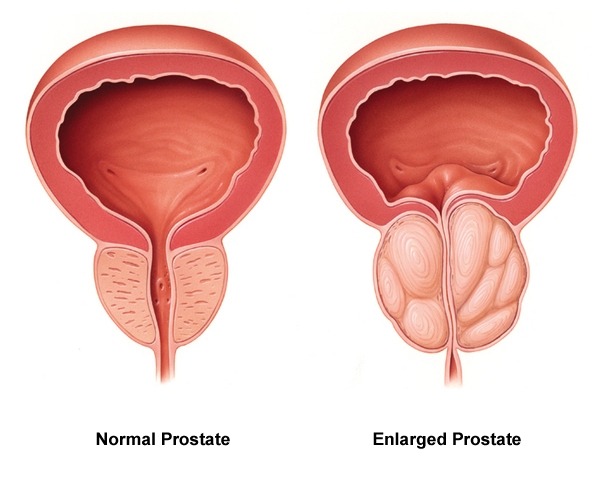
So what happens when BPH steps into the picture? Well, it doesn’t just call for a round of applause for being the larger structure. Bigger is not always better.
BPH is setting the stage for a series of problems, which we will discuss in the next section. Spoiler alert: an enlarged prostate might lead to symptoms that can be quite bothersome and disrupt your daily life.
Complications and Concerns Related to BPH
Now what are the issues if you are dealing with Benign Prostatic Hyperplasia? It’s not just about frequent bathroom trips, although that can be a bothersome aspect of BPH. Again about 12 years ago I remember my boss in the Bangkok office telling me that he would wake up 4 or 5 times a night because he needed to urinate. We all looked at him with surprise. He simply said, “Just wait, it will happen to you.”
This need to piss can be minimized by drinking less as the day progresses. But this is not a foolproof method. Part of the problem is with BPH you struggle to drain all of the urine out of your bladder because your urethra is partially blocked.
A prostate enlarged by BPH can cause a blockage of urine flow, which may lead to uncomfortable and sometimes serious complications.
Common problems associated with BPH range from urinary tract infections to bladder stones. And it doesn’t stop there. If left untreated, BPH can cause the bladder to weaken and lose its ability to empty fully, leading to chronic urinary retention. I’m talking about a scenario where urine stays trapped in your bladder, a situation nobody wants to be in.
Another complication you might not hear discussed as often is the impact BPH can have on your kidneys. Yes, that’s right — the back-up of urine can actually affect the kidneys, potentially leading to damage if the situation remains unresolved. These are the kinds of problems that can really affect your quality of life, causing not just pain and discomfort but potentially serious health issues down the line.
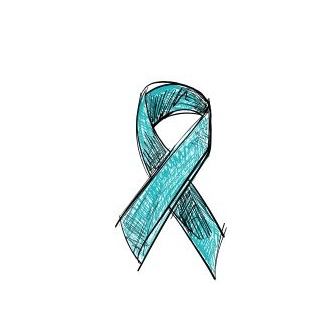
BPH can lead to cancer, it is one of the reasons you want to get checked if you are experiencing any symptoms and the reason why you should continue to get checked as you grow older.
Note: prostate cancer awareness is denoted by a blue ribbon, like the one shown here.
It is one of the slowest-growing cancers. So even if you do develop prostate cancer you should be ok and you should have time to deal with it. However, make sure you keep on top of it cancer is unpredictable and you may be the exception. This is not a medical website and we are not offering medical advice. We are just trying to inform you.
I have an article about a prostate cancer success story here.
Don’t worry too much; we’re not leaving you high and dry. After understanding these concerns, it’s clear that managing BPH symptoms is not only about improving quality of life but also about preventing more severe complications.
In the next section, ‘Managing BPH Symptoms: Tips and Strategies,’ we’ll look into how lifestyle changes and certain treatments can help you take charge of your prostate health. You’ll see that there are several approaches you can take to keep those symptoms in check.
Managing BPH Symptoms: Tips and Strategies
You might be feeling overwhelmed if you or someone you know has been diagnosed with Benign Prostatic Hyperplasia (BPH). Don’t worry too much about it. There are several effective strategies and tips that can help manage the symptoms. Reducing symptoms not only improves comfort but can also decrease the likelihood of complications. I’m going to share a few tips right here.
First and foremost – Get Checked
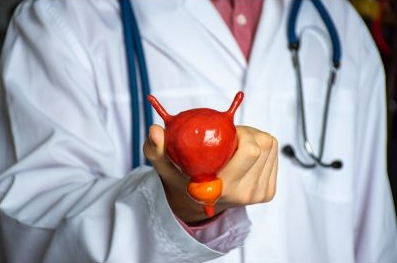
One of the first things is to get checked. Have a physical that includes a PSA (Prostate Specific Antigen) test, and an ultrasound of your abdomen to see if your prostate is enlarged or not.
I had one earlier this year and my prostate is ~3.5 cm, and my PSA numbers are low. I will continue to have my prostate checked every year from now on.
Everyone over 50 should have their prostate checked. In theory, over this age, you should get checked every year.
First up, focus on your diet. Choosing foods that are lower in fat and incorporating more fruits and vegetables can contribute to better prostate health. Additionally, try to limit your intake of caffeine and alcohol, as they can exacerbate urinary symptoms. – Ok, I get it, this one is hard to swallow. Nobody is asking you to become a health nut, just keep in mind that lifestyle can and will affect things.
Regular physical activity is another key factor. Exercise can help you maintain a healthy weight, which reduces pressure on the prostate. Plus, specific pelvic exercises can strengthen the muscles that control urination.
If you want to, consider the timing of your fluid intake. Drinking fewer fluids in the evening can reduce nighttime trips to the bathroom, ensuring better sleep.
Also, medications are available that can help ease the urinary symptoms of BPH, but as with any medication, there are potential side effects to discuss with your doctor.
Lastly, there are also various minimally invasive treatments available if lifestyle changes, and medication aren’t enough to relieve symptoms. These should be considered in discussion with a healthcare professional who can provide guidance based on the severity of your case.
I really hope that you find these tips useful. Stick with me, as future articles going to talk about when it’s time to move from managing BPH at home to seeking professional medical attention. That’s going to include understanding the warning signs and knowing when and how to involve your doctor.
Wrapping Up: Maintaining Prostate Health and Vigilance
That’s a lot to take in, I know, but understanding your prostate health is crucial, especially as you age. Just remember, it’s your body, and staying informed is your best defense.

So, what’s the big takeaway? Your prostate, that small gland located just below the bladder, plays a big role in your urinary and reproductive health.
And when things go awry, like with BPH, it can really interfere with your quality of life. But by being attentive to changes in your body and taking the right steps, you can manage or even alleviate symptoms.
Don’t worry too much about having all the answers right now when it comes to prostate health. It’s a journey, and you’re not expected to navigate it alone. If you’re dealing with symptoms or just have concerns about your prostate, talking to your doctor is a smart move. They are your ally in health and can provide personalized advice tailored to your needs.
If you are part of a national health care system, then get in early to get yourself checked. If you are late to the party and you have concerns, consider medical tourism to get checked. It is surprisingly affordable.
Choose a lifestyle that supports your prostate health. It could be as simple as regular exercise, a balanced diet, and staying hydrated. Prevention and early action are your friends here.
In my opinion, the best time to be concerned about your prostate is before issues arise. Regular check-ups are key, and while there’s no set age, starting discussions with your healthcare provider around 50—or sooner if you have a family history—is wise.
I really hope that this guide has illuminated not only the troubles that come with prostate issues but also the proactive steps you can take to maintain your prostate health. Don’t hesitate to reach out to health professionals for guidance, and remember, taking action today can significantly benefit your well-being tomorrow.
